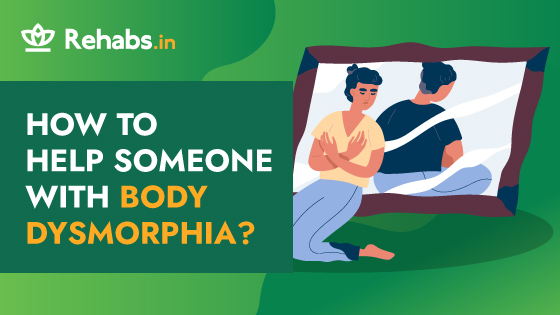How to help someone with body dysmorphia?

What is it like to have Body Dysmorphia?
We’ve all had days when it’s hard to look in the mirror without judging your appearance when you’re comparing your body to someone else’s or attempting to hide your flaws, using make-up and uncomfortable clothes to match society’s beauty standards. We all have certain parts of our faces or body that we don’t like or feel insecure about.
For a person with body dysmorphia, every day is that day. No matter what they’re doing, they can’t stop thinking of their flaws. The flaws that might not even be noticeable to others. They spend a lot of time comparing their physical appearance to others. It can be any part of the body but is most commonly some part of the face. In men, pre-occupation is seen with the overall body build and genitalia.
It is a very upsetting condition and can majorly impact people’s lives. It can also affect their social life, work, family and day-to-day functioning. This is most commonly seen in adolescents and young adults. This condition might co-occur with depression, anxiety or substance abuse.
According to the International Classification of Diseases, 11th edition (ICD-11), Body dysmorphic disorder is categorised under obsessive-compulsive disorders. These are a category of disorders characterised by repetitive thoughts or behaviours. Body dysmorphic disordered is defined as a persistent preoccupation with certain perceived flaws in the physical appearance, which are either unnoticeable or barely noticeable to others.
People with this disorder feel extremely self-conscious and might try to engage in excessive and repetitive behaviours to remove this flaw. They may repeatedly check their body, use mirrors excessively, attempt to hide certain parts or avoid social situations completely.
Why is it important to seek treatment for body dysmorphia?
Body dysmorphia doesn’t usually get better on its own if left untreated. It may, in fact, keep getting worse, leading to other mental health problems like eating disorders. It may also lead to self-harm or suicidal tendencies. However, for someone with body dysmorphia, it may be difficult to make the decision to seek help.
In some cases, people have some insight about their beliefs being excessive or untrue. They might, to some extent, accept that they are experiencing a condition called body dysmorphia. In others, there might be more conviction that their beliefs about their body are absolutely true. The less insight they have, the less likely they are to reach out for treatment.
When it comes to seeking treatment for any mental health disorder, people might be hesitant to seek treatment due to the stigma around it. Especially for body dysmorphia, people are reluctant to speak about it as people might perceive them as being vain or narcissistic. However, it is a real mental health disorder and can be extremely distressing to the person suffering.
More importantly, treatment is readily available. One need not go through life obsessing over bodily flaws which others do not even perceive. And inhibiting yourself because you feel that people are judging you or mocking your flaws. Or attempting to constantly hide or cover up these flaws.
You might even choose to get expensive cosmetic procedures with little to no satisfaction after. Getting treatment can help you face social situations without being preoccupied with your flaws. It can help you find and love your true self. So if you or someone you know experiences any signs of body dysmorphia, know that treatment is available.
People with BDD also show a high risk of suicide. If you’ve seen signs of self-harm, treatment has to be started immediately. People with a lack of social support or a feeling of burdensomeness or hopelessness might be at higher risk of suicide. The shame and stigma they might have faced around BDD may lead them to hide their symptoms, making it more difficult to diagnose them correctly.
Early intervention and treatment can improve prognosis and lead to quicker recovery. Seeking professional help can aid patients in understanding their condition. People might be able to see improvements almost immediately. This can help bring new hope and improve their general quality of life.
It is extremely important to encourage people with BDD to seek help and support them through their recovery journey. Emotional support is extremely essential in this process as they might be experiencing a lot of distress and shame. Friends and family members can educate themselves about the condition and treatment options.
How to help someone with Body dysmorphia?
We’ve understood why it’s important to help someone with body dysmorphia. Here are some tips on how you can show your support.
- Do not shame or stigmatise them: People with mental health disorders face a lot of stigmas. Avoid using any labels or trivialising their condition. Be careful about how you speak to them.
- Show empathy: People with body dysmorphia or any mental health disorders are often misunderstood and shamed. Try to show your support by listening to them. Try to understand their struggles and feelings while also respecting their space. While it may be difficult to understand what they’re going through, make sure you make them feel accepted and acknowledged.
- Educate yourself: Learn about the signs of BDD, the treatment options, and the associated stigma and struggles. Help educate other people around you as well.
- Encourage them to seek treatment: People with BDD might sometimes not even recognise these signs. Encourage them to speak to a professional who can help them understand the condition and their treatment options.
- Identify their triggers: There might be certain situations that can provoke people with BDD. These can be meeting certain people or coming across the mirror in public. Understanding their triggers can help you provide them with support when they need it most.
- Do not make comments about their appearance: The main symptom of BDD is a preoccupation with flaws in their appearance. They fear that people might judge them for their appearance, which leads them to avoid social situations. Do not reinforce their beliefs by making any critical comments about their body.
- Boost their confidence: You can encourage them to do things they enjoy. You can also give them genuine compliments that aren’t related to their appearance. This can help them develop their self-esteem.
- Engage in self-love and self-care practices: Plan to do activities with them that would promote overall well-being. For example, exercising, playing a sport, engaging in a hobby of theirs, cooking a healthy meal together or meditating. This may encourage them to spend some positive time with themselves.
- Be patient: The treatment journey for BDD might not be a quick, easy one. It may take time and constant effort. Make sure your loved one stays committed to their treatment.
- Encourage them: When they show improvement in their condition, you can celebrate and appreciate their little successes.
In this journey, you might find that your support matters a lot in their recovery. This can be stressful and difficult for you as well. Look out for support groups which can connect you to people in a similar situation. If required, you can also seek help for yourself.
Cognitive behaviour therapy (CBT) and pharmacotherapy are seen to be most effective for BDD. For treatment facilities and mental health professionals, browse our list here.
Sources:
Body dysmorphic disorder (BDD). nhs.uk. https://www.nhs.uk/mental-health/conditions/body-dysmorphia/
Phillips, K. A. (2004, February 1). Body dysmorphic disorder: recognizing and treating imagined ugliness. PubMed Central (PMC). https://www.ncbi.nlm.nih.gov/pmc/articles/PMC1414653/
World Health Organization. (2022). ICD-11 for Mortality and Morbidity Statistics (11th ed.). https://icd.who.int/en














